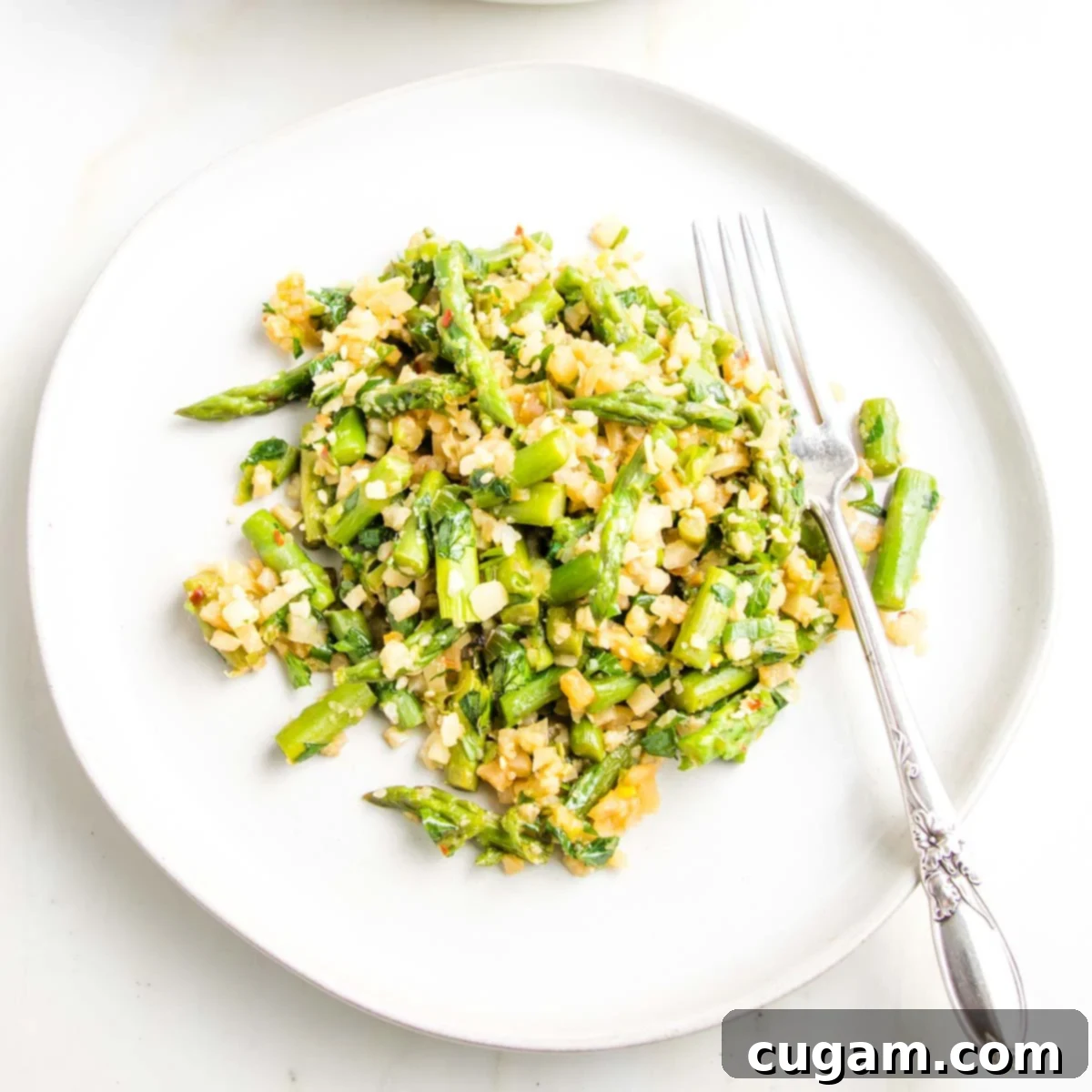Quick & Easy Vegan Cauliflower Rice with Asparagus: Your 15-Minute Low-Carb Side Dish Solution
Discover the ultimate healthy side dish that doesn’t compromise on flavor or satisfaction! This incredibly versatile Vegan Cauliflower Rice with Asparagus recipe is not only bursting with vibrant taste but is also incredibly fast to prepare, ready to serve in just 15 minutes. It’s a game-changer for anyone looking for a low-carb, grain-free, and enormously satisfying addition to their meal, proving that healthy eating can be both delicious and convenient.
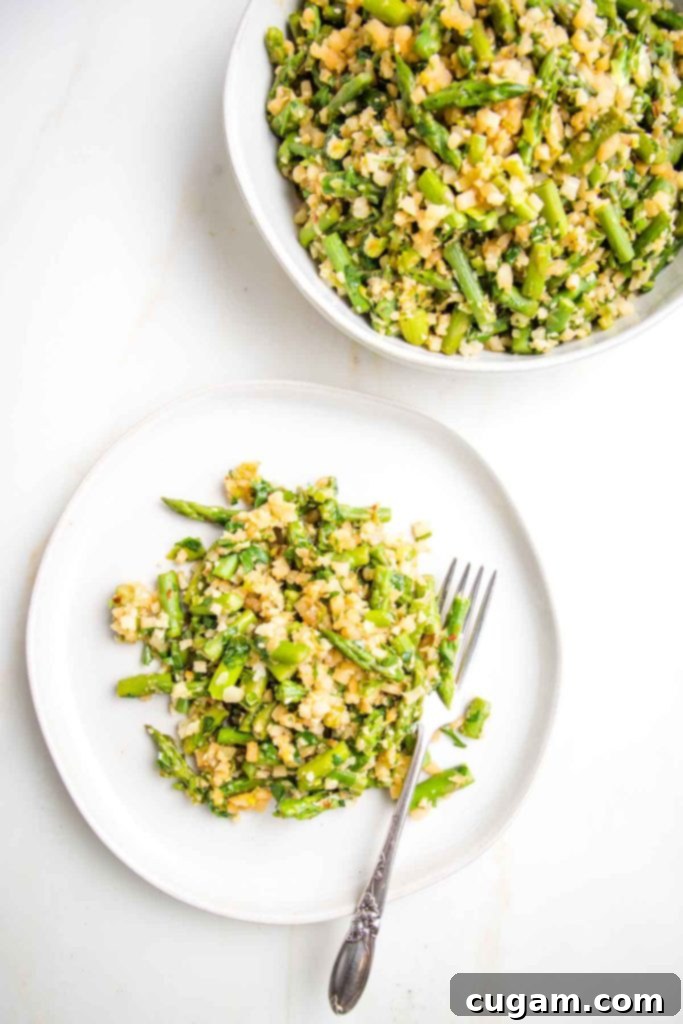
[feast_advanced_jump_to]
Are you constantly battling those nagging carb cravings? We’ve all been there! But what if we told you there’s a delightful solution that makes your taste buds sing and your body thank you? Our Vegan Cauliflower Rice with Asparagus recipe is precisely that. It’s designed to trick your brain into thinking you’re indulging in a hearty, carb-laden treat, while in reality, you’re enjoying a dish that’s remarkably low on the glycemic index. This means stable blood sugar levels and a happy waistline, without sacrificing an ounce of flavor.
Imagine this: a mouth-watering, deeply satisfying side dish that you can whip up in just 15 minutes, and it counts as a healthy serving of vegetables. Even better, it’s a “twofer” – because it’s entirely composed of wholesome veggies, yet it carries the comforting texture and appeal of traditional rice. You’d truly never guess! So, if you’re ready to embrace delicious, guilt-free eating, this easy cauliflower rice recipe is about to become a staple in your kitchen. Get ready to make it again and again, because it’s simply that good!
Essential Ingredients and Clever Substitutions for Your Cauliflower Rice
The beauty of this quick cauliflower rice recipe lies in its simple, wholesome ingredients and the flexibility to adapt it to whatever you have on hand. Each component plays a vital role in creating its incredibly vibrant and aromatic flavor profile. Don’t be afraid to experiment with these suggested substitutions to make it truly your own!
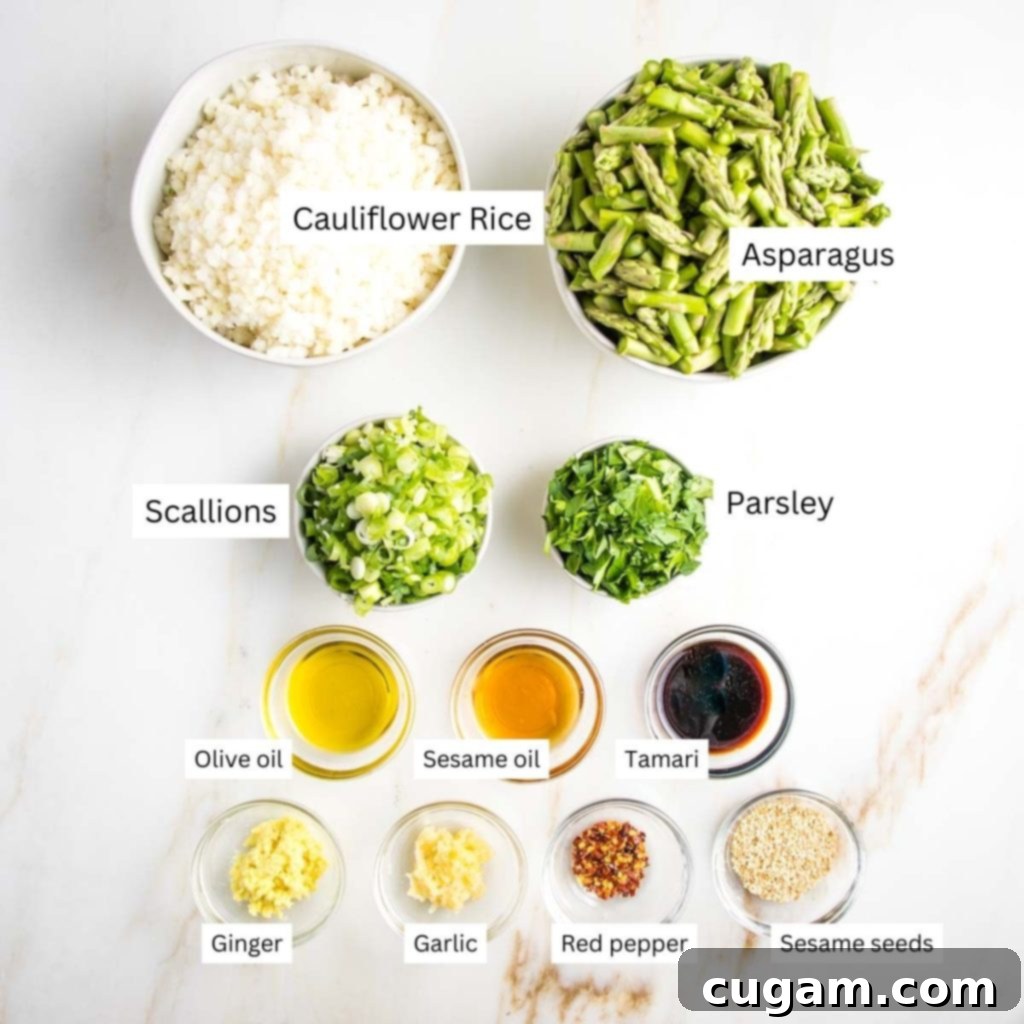
- Cauliflower Rice: The star of our low-carb show! Riced cauliflower has soared in popularity, making it readily available in most grocery stores, either fresh or frozen. This convenience is a huge time-saver. If you’re feeling adventurous or want to save a bit of money, you can easily rice a fresh head of cauliflower yourself (more on that below!). For an interesting twist, consider substituting with riced broccoli or even riced parsnips for a slightly sweeter profile.
- Asparagus: These tender-crisp green spears add a delightful texture and a fresh, slightly earthy flavor. When choosing asparagus, look for firm, bright green stalks with closed, compact tips. If asparagus isn’t in season or you prefer another vegetable, feel free to substitute with diced zucchini, broccoli florets, green beans, or any other quick-cooking vegetable that you and your family enjoy.
- Scallions (Green Onions): Crucial for that fresh, pungent, yet mild oniony kick that truly elevates the dish. They add a layer of aromatic complexity. If scallions aren’t available, finely diced white or yellow onions can work, though they’ll have a stronger flavor. Thinly sliced leeks would also make a lovely, delicate substitute.
- Fresh Parsley: Provides a burst of fresh, herbaceous brightness that cuts through the rich flavors. While parsley is fantastic, fresh cilantro would lend a more distinctly Asian-inspired aroma, and a pinch of dried or fresh oregano could offer a Mediterranean flair if you’re looking to shift the flavor profile.
- Olive Oil: Used for sautéing the vegetables and building the initial flavor base. If you’re aiming for an oil-free cauliflower rice recipe, you can easily substitute water or vegetable broth when sautéing the asparagus. Just be sure to watch the pan closely to prevent sticking.
- Toasted Sesame Oil: This ingredient is a flavor powerhouse, instantly infusing the dish with that characteristic nutty, umami-rich Asian taste. A little goes a long way! If you prefer to cook without oil, you can skip this liquid form and instead dry toast regular sesame seeds in a skillet until fragrant before adding them at the end. This brings out their natural oils and flavor beautifully.
- Tamari: Our gluten-free alternative to soy sauce, providing a deep, savory, umami depth. We highly recommend opting for low-sodium and organic tamari whenever possible to control salt intake and ensure quality ingredients. If gluten isn’t an issue, regular low-sodium soy sauce is a fine substitute.
- Fresh Ginger: Trust us, fresh ginger makes all the difference! Its warm, zesty, slightly spicy notes are irreplaceable. While fresh is best, you can also find pre-grated ginger in the freezer section of many grocery stores, often in convenient “ice cube” portions, which are great for saving time.
- Garlic: Like ginger, fresh garlic offers superior flavor compared to garlic powder. It provides a pungent, aromatic foundation. However, in a pinch, a small amount of garlic powder (about ½ teaspoon per clove) can be used, but adjust to taste.
- Crushed Red Pepper Flakes: For a delightful touch of heat and visual appeal. This allows you to customize the spice level. If you prefer a more subtle warmth or a smoky flavor, white pepper is an excellent alternative. For a simple everyday option, freshly ground black pepper also works well.
- Sesame Seeds: These tiny seeds add a fantastic textural crunch and a delicate nutty flavor. For an even more intense sesame aroma and taste, dry toast the seeds in a separate small, dry skillet over medium-low heat for a few minutes until they are lightly golden and fragrant before sprinkling them generously over your finished cauli-rice.
Why This is the BEST Vegan Cauliflower Rice Recipe You’ll Ever Make
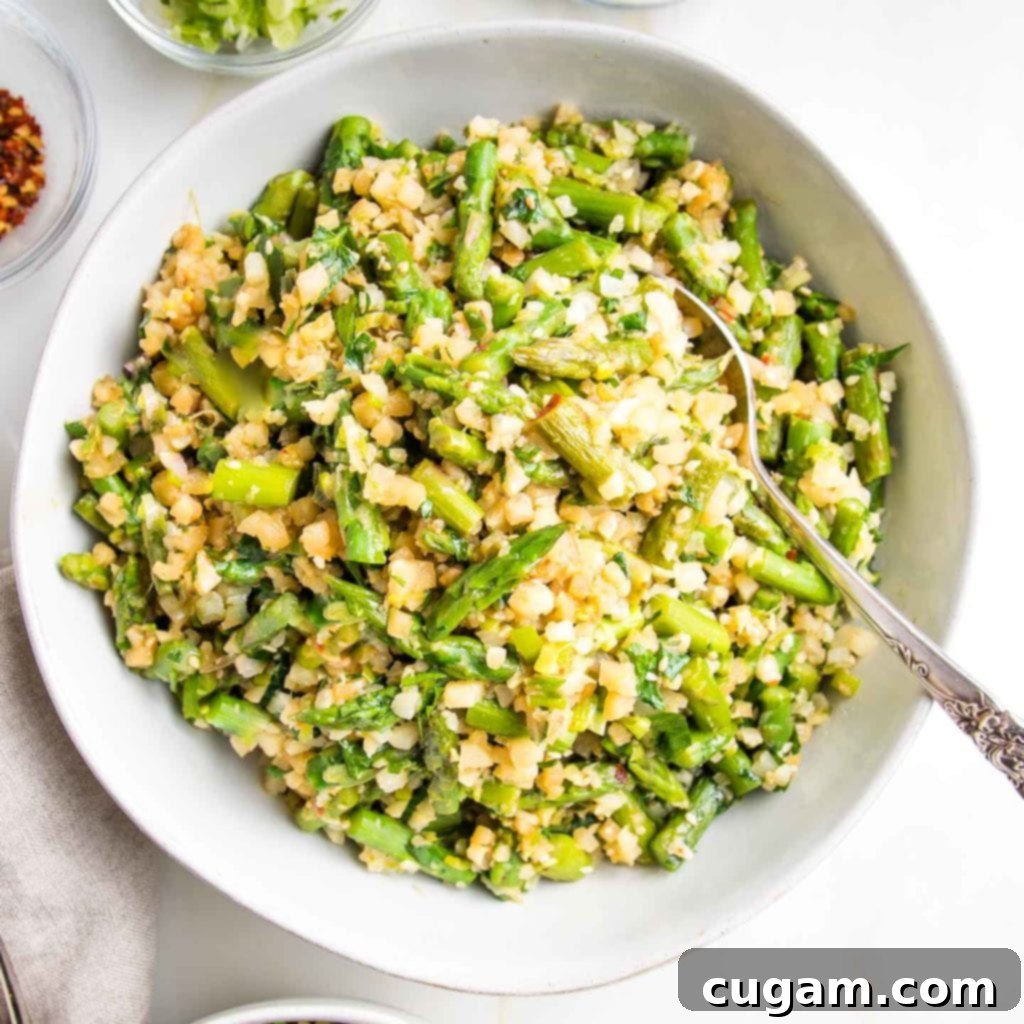
- Quick and Easy: In today’s fast-paced world, finding time for healthy cooking can be a challenge. This recipe is designed with your busy schedule in mind, going from prep to plate in a mere 15 minutes. It’s the ideal solution for a nutritious weeknight side dish when time is of the essence, without resorting to unhealthy takeout.
- Tastes Absolutely Incredible!: Cauliflower on its own can sometimes be a bit bland, but not in this recipe! The dynamic trio of fresh ginger, fragrant garlic, and crisp scallions creates an explosion of aromatic flavors that transform plain cauliflower into a culinary delight. Add in the savory tamari and nutty sesame oil, and you have a side dish that’s rich, complex, and utterly addictive.
- One Pan, Easy Clean Up: Who loves doing dishes? Nobody! This recipe minimizes cleanup by utilizing just one large skillet or wok from start to finish. This not only makes the cooking process smoother but also ensures you spend less time scrubbing and more time enjoying your delicious meal.
- Simple, Accessible Ingredients: You won’t need to hunt down obscure ingredients for this recipe. Most of the items—cauliflower, asparagus, ginger, garlic, tamari—are common pantry staples or readily available at any local grocery store. This makes it a go-to recipe for spontaneous healthy cooking.
- Packed with Plant-Based, Grain-Free Nutrition: For those following a vegan, gluten-free, or grain-free diet, this cauliflower rice is a nutritional powerhouse. It’s loaded with essential vitamins, minerals, and fiber from whole plant-based ingredients, making it an excellent choice for a wholesome meal that supports various dietary needs.
- Incredibly Versatile: This recipe is a fantastic canvas for creativity. It adapts beautifully to whatever fresh or frozen vegetables you have on hand. Don’t have asparagus? Try frozen peas, diced bell peppers, shredded carrots, or even mushrooms. I’ve personally used frozen peas when fresh veggies were scarce, and it was absolutely delicious – a true testament to its adaptability!
- Low in Calories, Low in Carbs, and Low on the Glycemic Index: This dish is a dream come true for anyone mindful of their calorie or carbohydrate intake. Being low on the glycemic index means it won’t cause sharp spikes in your blood sugar, making it an excellent choice for diabetics or those managing their weight.
- Excellent Side Dish That Feels “Starchy” and “Carb-y” but is Truly Another Veggie: This is the ultimate comfort food hack! It delivers the satisfying mouthfeel and hearty presence typically associated with starchy sides like rice, but it’s purely a vegetable. You get all the comfort and satiety without the heavy carbs, making healthy eating feel indulgent.
- Everyone Will LOVE It – You’ll Be a Superstar! From picky eaters to health enthusiasts, this flavorful cauliflower rice has a broad appeal. Its delicious taste and comforting texture make it a crowd-pleaser, ensuring rave reviews at your dinner table. Get ready to take a bow, because you’re about to become a culinary superstar!
The Best Way to Store Fresh Asparagus for Maximum Longevity
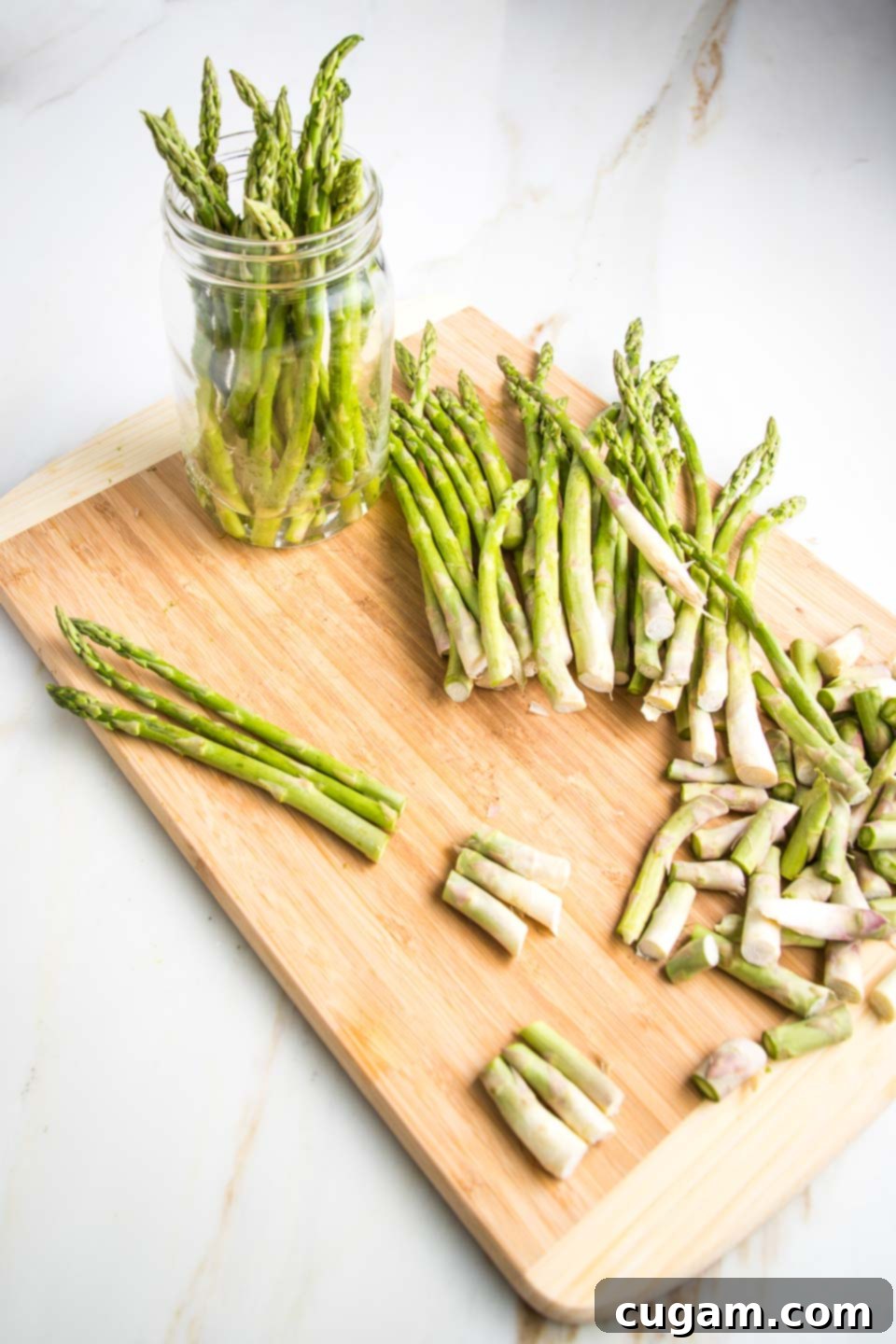
To ensure your asparagus stays fresh, crisp, and flavorful for as long as possible, follow this simple storage tip as soon as you get home from the grocery store. First, trim about an inch off the bottom ends of the asparagus stalks. This fresh cut allows the spears to absorb water more effectively. Then, place the trimmed asparagus upright in a glass jar or a tall container with about an inch of water at the bottom, just like a bouquet of flowers. Loosely cover the top of the container with a plastic bag or plastic wrap to create a mini-greenhouse effect, which helps retain moisture. Store this in your refrigerator. This method prevents the asparagus from drying out and wilting, keeping it vibrant and ready for your recipes for up to a week or more.
How to Effortlessly Make Cauliflower Rice at Home
Transforming a fresh head of cauliflower into a grain-like consistency that perfectly mimics rice is surprisingly simple and much easier than you might think! It’s also often more cost-effective than buying pre-riced cauliflower and allows you to control the texture. My preferred method uses a food processor because it’s incredibly quick and efficient. However, if you don’t have a food processor, a box grater works just as well, albeit with a bit more elbow grease.
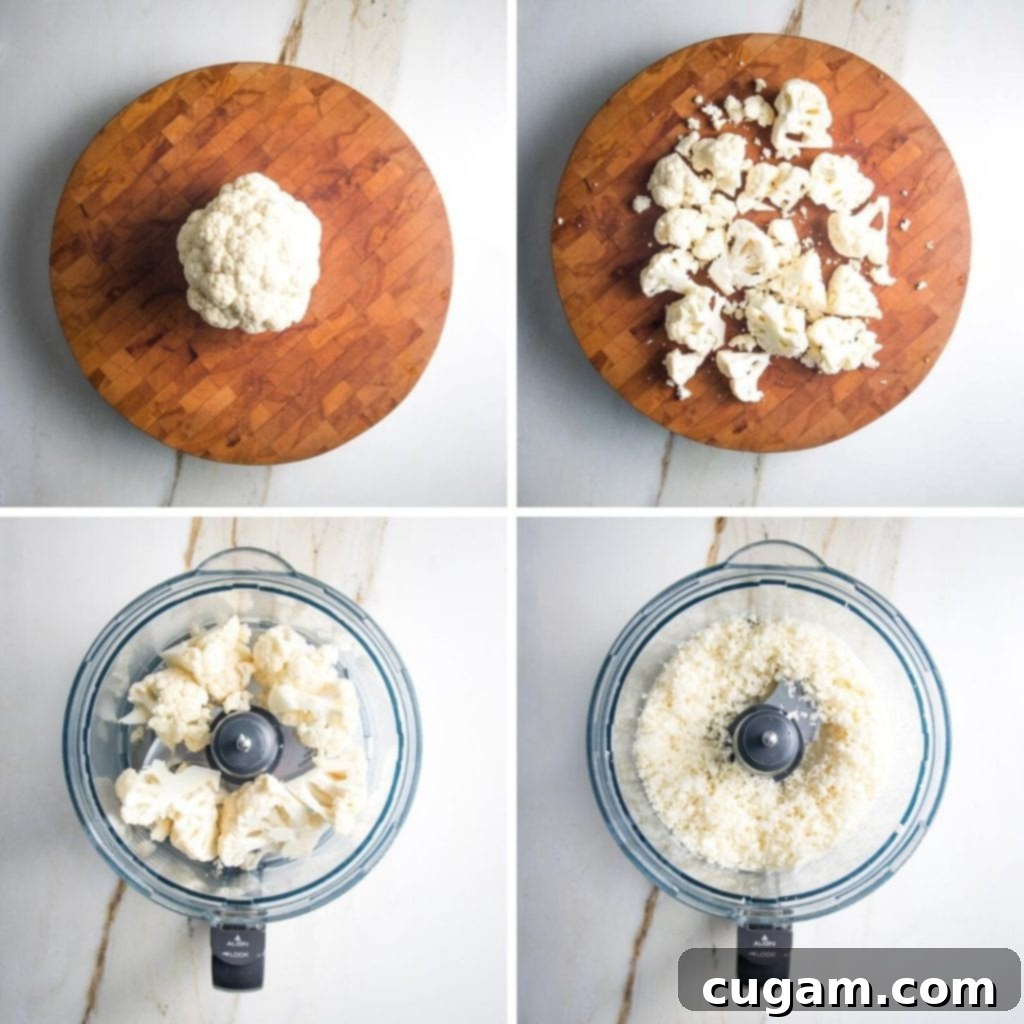
- Preparation: Start by washing and thoroughly drying your head of cauliflower. Remove the outer leaves and then halve the cauliflower. Cut it into manageable chunks, ensuring they are small enough to fit comfortably into your food processor’s bowl or to handle easily with a grater. Don’t discard the core! It can also be riced, ensuring zero waste.
- Using a Food Processor: Place the cauliflower chunks into your food processor. The key here is to use the “pulse” function. Pulse in short bursts, scraping down the sides as needed, until the cauliflower breaks down into small, uniform pieces that resemble grains of rice. Be careful not to over-process, as this can turn the cauliflower into a mushy paste rather than distinct “rice” grains. Work in batches if necessary to avoid overcrowding the processor.
- Using a Box Grater: If you don’t have a food processor, a standard box grater is a great alternative. Use the side with the medium-sized holes (the same one you might use for cheese). Simply grate the cauliflower florets and chunks against the grater until you achieve a rice-like texture. This method might take a little longer but yields excellent results.
- Time-Saving Tip: If you’re short on time or prefer convenience, readily riced cauliflower (both fresh and frozen) is widely available in the produce or freezer sections of most grocery stores. While making your own offers a fresher taste and saves money, store-bought riced cauliflower is a perfectly acceptable shortcut for this recipe.
Step-by-Step Guide: How to Make This Delicious Cauliflower Rice with Asparagus
Get ready to create a flavorful and healthy side dish in just a few simple steps. The entire process is designed to be quick, easy, and yields incredible results!
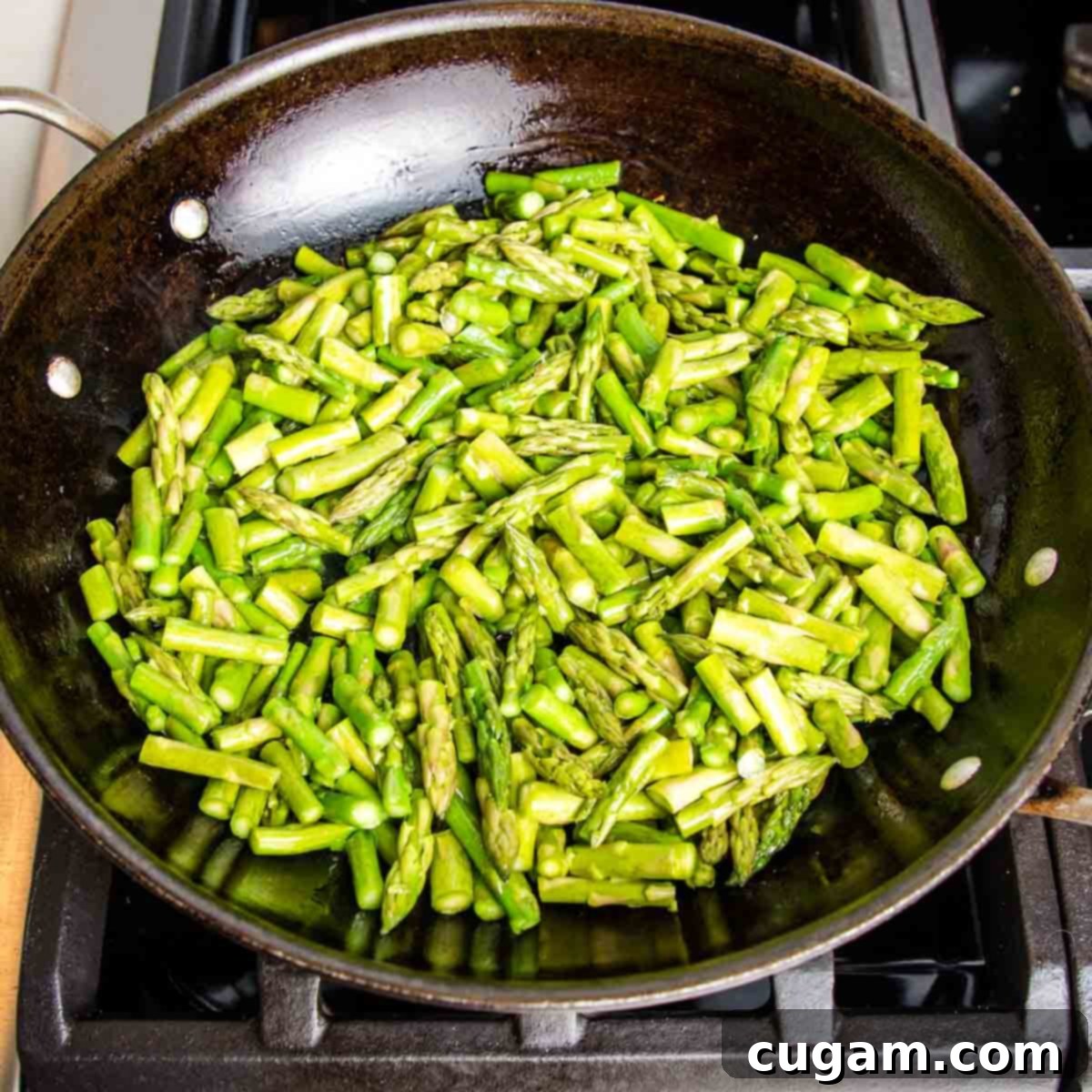
Step 1: Sauté the Asparagus. Begin by heating a large, heavy skillet (a cast iron skillet works wonderfully for even heat distribution) over medium to medium-high heat. Add your olive oil (or water/broth for oil-free) and then the trimmed and cut asparagus. Cook for about 2 minutes, tossing gently and consistently. You’re looking for the asparagus to turn a vibrant, bright green and become slightly tender-crisp, but not soft or mushy. This quick sauté ensures they retain their delightful texture.
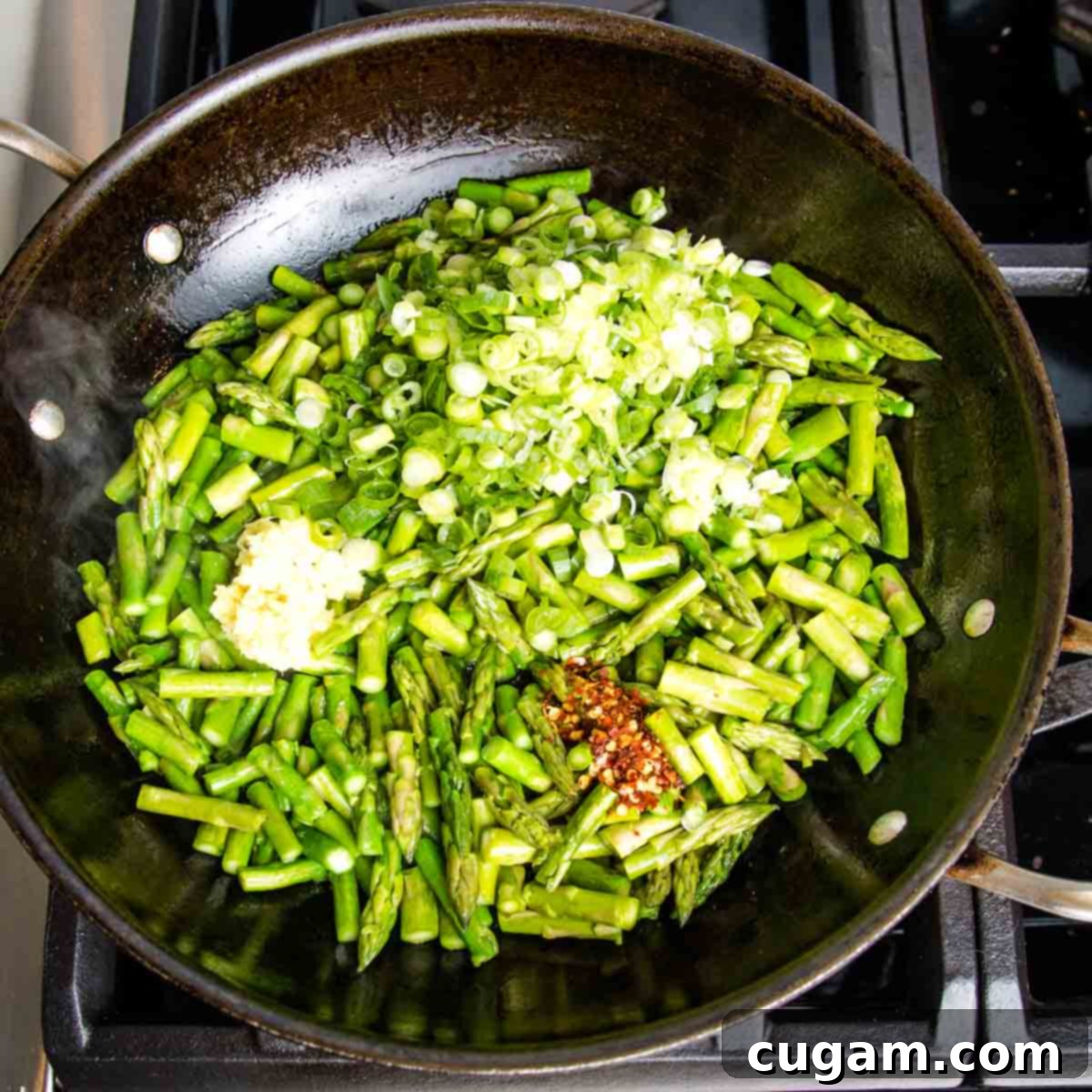
Step 2: Infuse with Aromatics. Once the asparagus is bright green, add in the grated fresh ginger, thinly sliced scallions, and a pinch of crushed red pepper flakes. Continue to cook and stir for another 1-2 minutes. This step is crucial for releasing the incredible aromas and flavors from these ingredients. The kitchen will begin to fill with a divine, fragrant scent as the ginger and scallions soften and become more aromatic. Be careful not to burn the ginger or scallions.
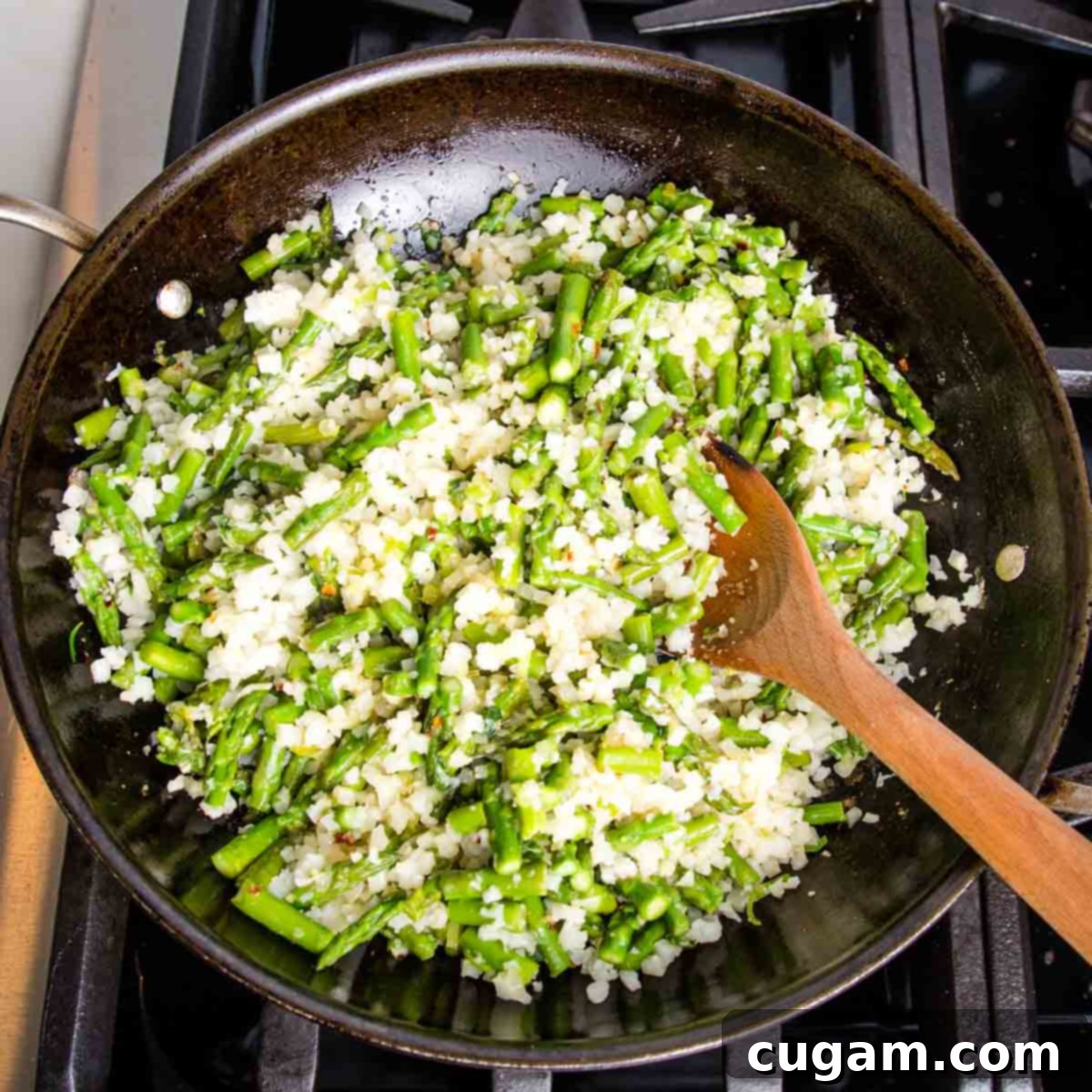
Step 3: Add Garlic, Cauliflower Rice & Seasonings. Now, add the fresh minced or zested garlic to the pan. Cook for just 1 minute, stirring constantly, to ensure it doesn’t burn (burnt garlic can taste bitter). Immediately follow with the riced cauliflower (whether fresh or frozen), toasted sesame oil, and tamari. Mix everything thoroughly, stirring until the cauliflower rice is fully heated through. If you are using frozen cauliflower rice, it may take a couple of extra minutes for any excess water to evaporate, ensuring a desirable texture. Continue to stir occasionally to ensure even cooking.

Step 4: Finish with Fresh Herbs and Serve. Finally, stir in the chopped fresh parsley (or cilantro) and the sesame seeds. Turn off the heat and continue to toss the mixture for a moment or two as the fresh herbs gently wilt into the warm cauliflower rice. This step ensures their vibrant flavor and color remain prominent. Taste the dish and adjust seasonings if needed; a little extra tamari or a pinch of salt can make all the difference. Garnish with additional scallions, red pepper flakes, or sesame seeds for an extra touch of flavor and visual appeal. Serve your delicious Vegan Cauliflower Rice with Asparagus warm or at room temperature, and enjoy!
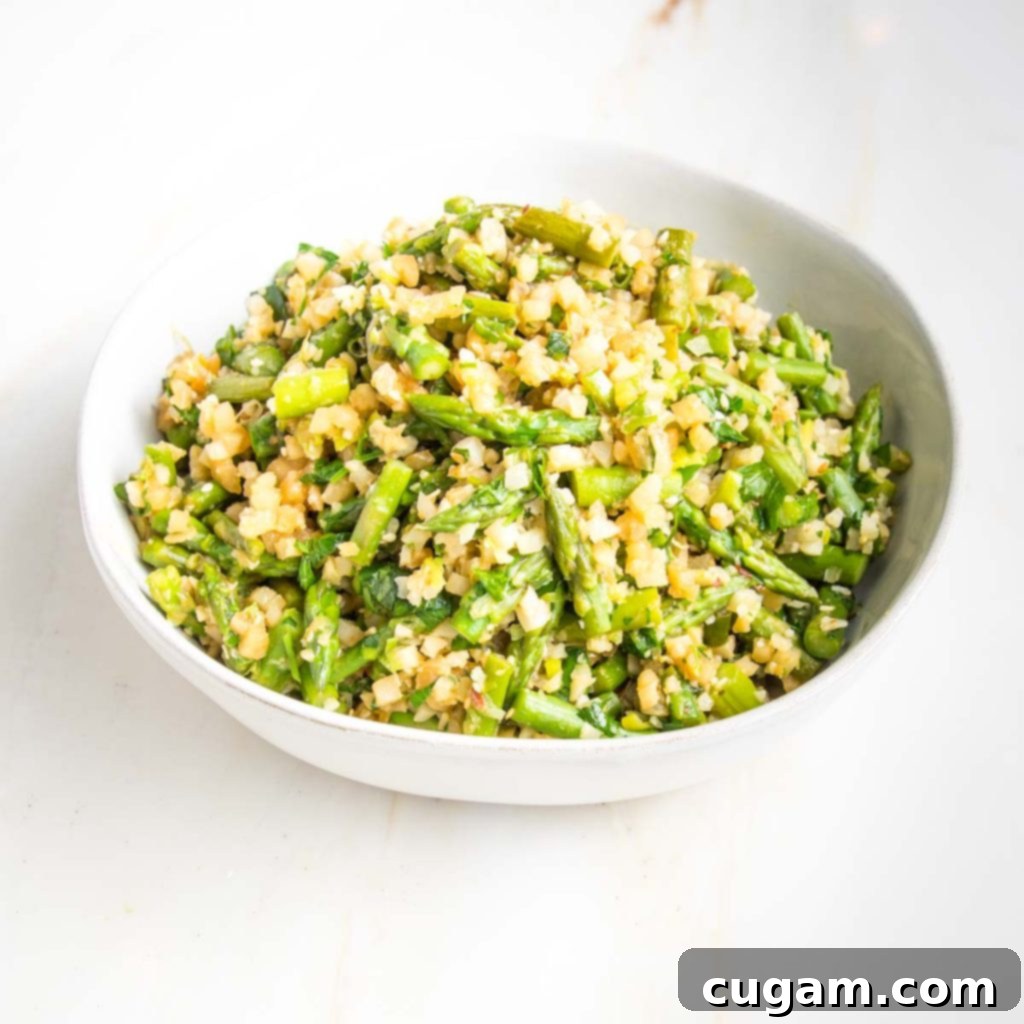
Serving Suggestions, Storage, and Freezing Tips
- How to Serve: This easy cauliflower rice side dish is incredibly versatile and pairs wonderfully with a variety of main courses. Serve it warm or at room temperature. It would be absolutely delicious alongside Crispy Baked Tofu for a satisfying protein boost, or as a flavorful accompaniment to Tofu Satay skewers. It also complements hearty Quinoa Veggie Burgers or a comforting slice of Vegan Meatloaf beautifully, adding a fresh, low-carb element to your plate.
- Storing Leftovers: Any leftover Vegan Cauliflower Rice with Asparagus can be stored in an airtight container in the refrigerator for up to 5-7 days. Its flavors tend to meld even further overnight, making it a great option for meal prepping healthy lunches or quick dinners.
- Freezing for Later: This dish freezes well! Once completely cooled, transfer the cauliflower rice to freezer-safe bags or containers. Remove as much air as possible to prevent freezer burn. It can be frozen for up to 3 months. Thaw overnight in the refrigerator before reheating.
- Reheating Instructions:
- Skillet Method: For a quick reheat, warm the cauliflower rice in a heavy skillet over medium heat, stirring occasionally, until it’s heated through. Add a splash of water or broth if it seems too dry.
- Oven Method (Regular): Spread the cauliflower rice in a single layer on a baking dish and reheat in a preheated 350-degree Fahrenheit (175°C) oven for about 15 minutes, or until warm.
- Oven Method (For Crispy Cauliflower Rice): If you prefer a slightly crispier texture, spread the cauliflower rice in a single layer on a rimmed baking tray. Reheat in a hotter oven, preheated to 425 degrees Fahrenheit (220°C), for about 15 minutes, tossing once halfway through. This high heat helps evaporate moisture and develop a lovely, slightly browned finish.
Debra’s Pro Tips for the Best Cauliflower Rice Experience
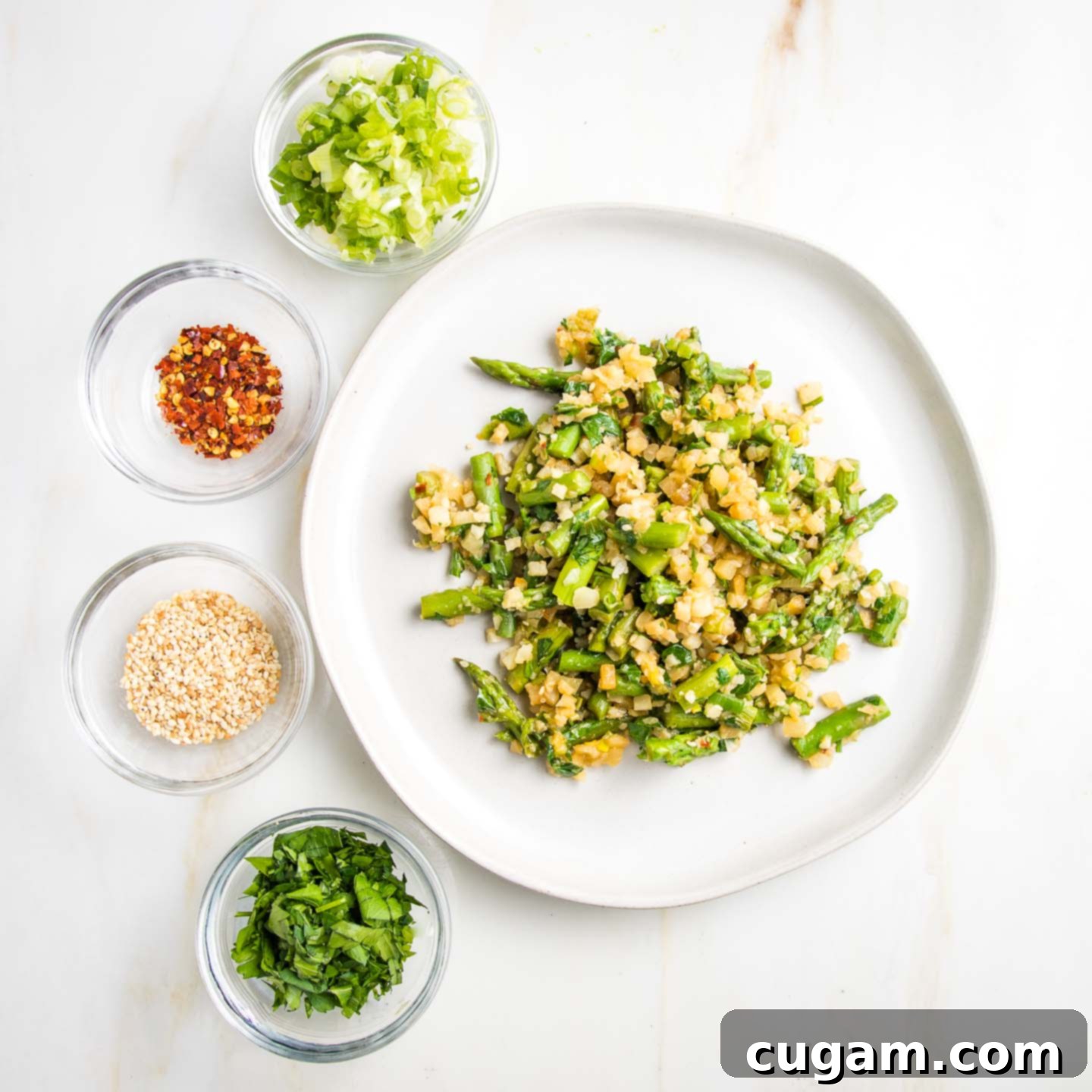
- Layer on the Flavor: For an even more vibrant and intense flavor experience, don’t be shy with your garnishes! Sprinkle a bit of extra fresh parsley or cilantro, a few more crushed red pepper flakes for an added kick, extra toasted sesame seeds for crunch, or a final scattering of sliced scallions right before serving. These fresh additions will brighten the dish beautifully.
- Mise en Place is Your Friend: This dish comes together incredibly quickly, so having all your ingredients prepped and ready before you start cooking is key. This French culinary term, meaning “everything in its place,” will save you time and prevent any last-minute scrambling. Chop your veggies, grate your ginger and garlic, and measure out your liquids before you even turn on the stove.
- SAVE TIME: If convenience is your top priority, take advantage of already “riced” cauliflower. You can find it in both the fresh produce section and the freezer aisle of most major grocery or big box stores. This shortcut allows you to get this healthy meal on the table even faster on those extra busy days.
- SAVE MONEY: For those who prefer a more budget-friendly approach, ricing your own cauliflower is incredibly simple and economical. All you need is a food processor (for speed) or a good old-fashioned box grater (for a bit more arm work). This method ensures you get fresh, perfectly textured cauliflower rice without the premium price tag.
- Experiment with Greens: While cauliflower is fantastic, don’t limit yourself! Try using riced broccoli instead of cauliflower for a truly green and equally nutritious side dish. The flavor profile will be slightly different, but just as delicious and packed with goodness. This is a great way to introduce variety and different nutrients into your diet.
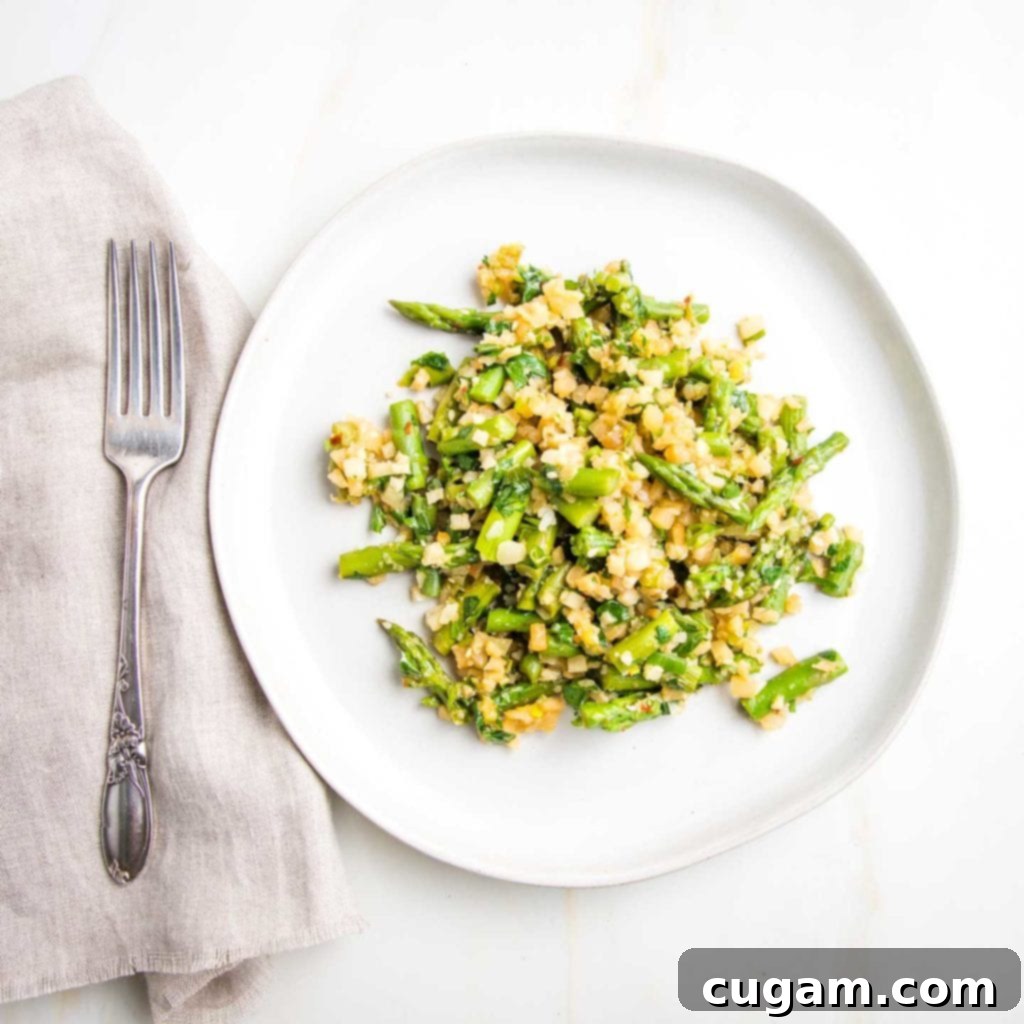
Explore More Healthy Vegan Cauliflower Recipes
If you loved this Vegan Cauliflower Rice with Asparagus, you’re in for a treat! Cauliflower is an incredibly versatile vegetable, perfect for creating a wide array of healthy, delicious, and often low-carb or plant-based meals. From fresh salads to hearty soups and savory dips, its mild flavor and adaptable texture make it a star ingredient. Dive into these other fantastic vegan cauliflower recipes to expand your culinary repertoire:
- Raw Cauliflower Salad with Lime
- Vegan Cauliflower Soup with Red Lentils
- Roasted Cauliflower Hummus Recipe
- Whole Roasted Cauliflower Recipe
Did you know commenting and rating recipes is one of the best ways to support your favorite food bloggers? If you made this delicious Vegan Cauliflower Rice with Asparagus, please consider leaving a five-star rating below and a comment sharing your experience. We love hearing from you! Also, we’d be thrilled if you shared your culinary creations on Instagram by tagging me @dkhealthcoach and using the hashtag #debraklein. Your support helps us continue to create and share healthy, plant-based recipes!
📖 Recipe
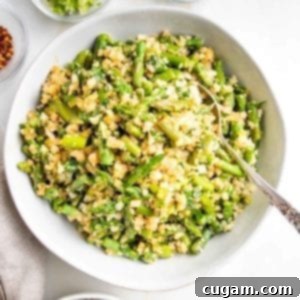
Cauliflower Rice with Asparagus
Rate this Recipe
Pin Recipe
Equipment
-
Cast iron skillet
-
Microplane
Ingredients
- 1 Tablespoon olive oil water sub totally fine
- 1 ½ lbs. asparagus
- 1-2 teaspoons grated ginger *
- 4 scallions
- ¼ teaspoon red pepper flakes
- 4-6 cloves garlic zested*
- 1 Tablespoon toasted sesame oil *
- 1 Tablespoon Tamari *
- 1 12-oz. package frozen cauliflower rice*
- ½ cup chopped fresh parsley or cilantro
- 1 Tablespoon sesame seeds *
Instructions
-
Prep All Your Veggies: Before you begin cooking, ensure all your ingredients are prepped. Trim the woody ends off the asparagus and cut the stalks into ½-inch sections. Use a microplane zester to finely grate the fresh ginger and garlic. Thinly slice the scallions, separating the white and green parts if desired, and chop your fresh parsley or cilantro.
-
Sauté Asparagus: Heat a large, heavy skillet over medium-high heat. Add the olive oil (or water/broth for an oil-free option). Once hot, add the cut asparagus and cook, tossing gently for about 2 minutes, until the asparagus starts to turn a bright green and is slightly tender-crisp.
-
Add Aromatics: Incorporate the grated ginger, sliced scallions, and red pepper flakes into the skillet. Cook for an additional 2 minutes, tossing occasionally, to allow the flavors to deepen and become fragrant. Next, add the zested garlic and cook, stirring constantly for just 1 minute to prevent it from burning, which can make it bitter.
-
Combine with Cauliflower Rice and Seasonings: Sprinkle the toasted sesame oil and tamari over the vegetables. Add the cauliflower rice to the skillet (it’s perfectly fine if it’s coming straight from the freezer). Toss all the ingredients together as you cook for 2 minutes. Continue to toss and cook until the cauliflower is thoroughly heated through and any excess moisture from frozen cauliflower rice has evaporated.
-
Finish and Serve: Stir in the fresh parsley (or cilantro) and sesame seeds. Turn off the heat and continue to toss the mixture until the fresh herbs have wilted slightly from the residual heat. Taste for seasoning and add additional tamari or a pinch of salt if needed. Garnish with extra scallions, crushed red pepper, and sesame seeds for added flavor and visual appeal. Serve warm or at room temperature.
-
Storage: Leftover asparagus cauli-rice will stay fresh and delicious in an airtight container in the fridge for up to 5 days. Reheat in a heavy skillet over medium heat or spread flat on a rimmed baking sheet and warm in a 350-degree F (175°C) oven for 15 minutes.
Notes
GINGER: I personally love the spicy, warm kick that ginger provides, so I recommend using a microplane to get 2 juicy teaspoons. If you’re new to cooking with fresh ginger or prefer a milder flavor, start with just 1 teaspoon – it will still add a delightful aromatic depth to the dish. You can always add more to taste.
GARLIC: While a garlic press works, since you likely already have your microplane zester out for the ginger, why not save yourself an extra dish to wash? Zesting garlic with a microplane also minimizes waste and creates a super fine texture that melts into the dish.
FRESH HERBS: For this recipe, either flat-leaf parsley or fresh cilantro will work beautifully, or feel free to use a combination of both for a more complex herbaceous note.
PASSOVER ADAPTATIONS: To make this delicious recipe suitable for Passover, you’ll need to make a few simple adjustments. Replace the tamari with 1 teaspoon of salt (or to taste). If you are omitting oil, substitute the toasted sesame oil with 1-2 tablespoons of water or vegetable broth to prevent sticking. Lastly, replace the sesame seeds with chopped nuts (such as almonds or walnuts) for texture, or simply omit them entirely if nuts are not desired.
Nutrition
Note
The nutrition calculations were done using online tools. To obtain the most accurate representation of the nutritional information in any given recipe, you should calculate the nutritional information with the actual ingredients you used. You are ultimately responsible for ensuring that any nutritional information is accurate, complete and useful.
